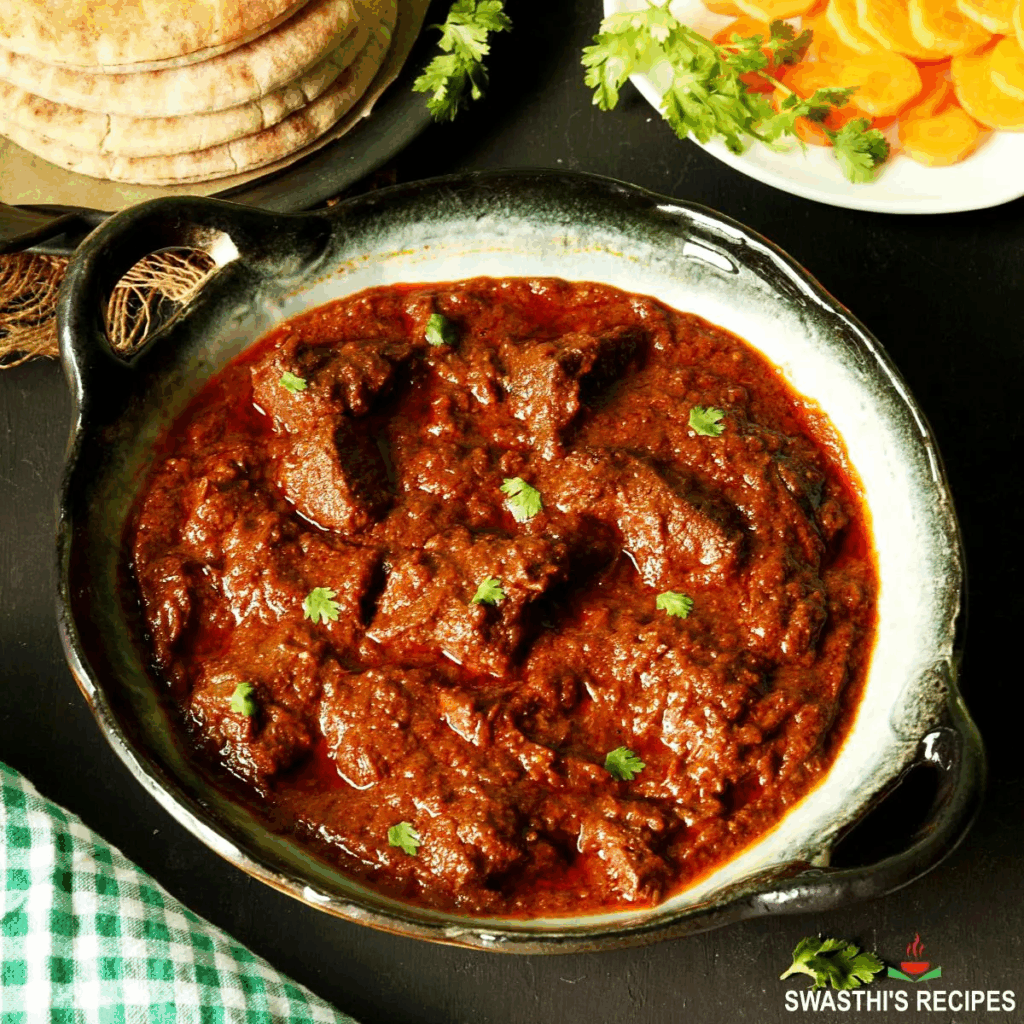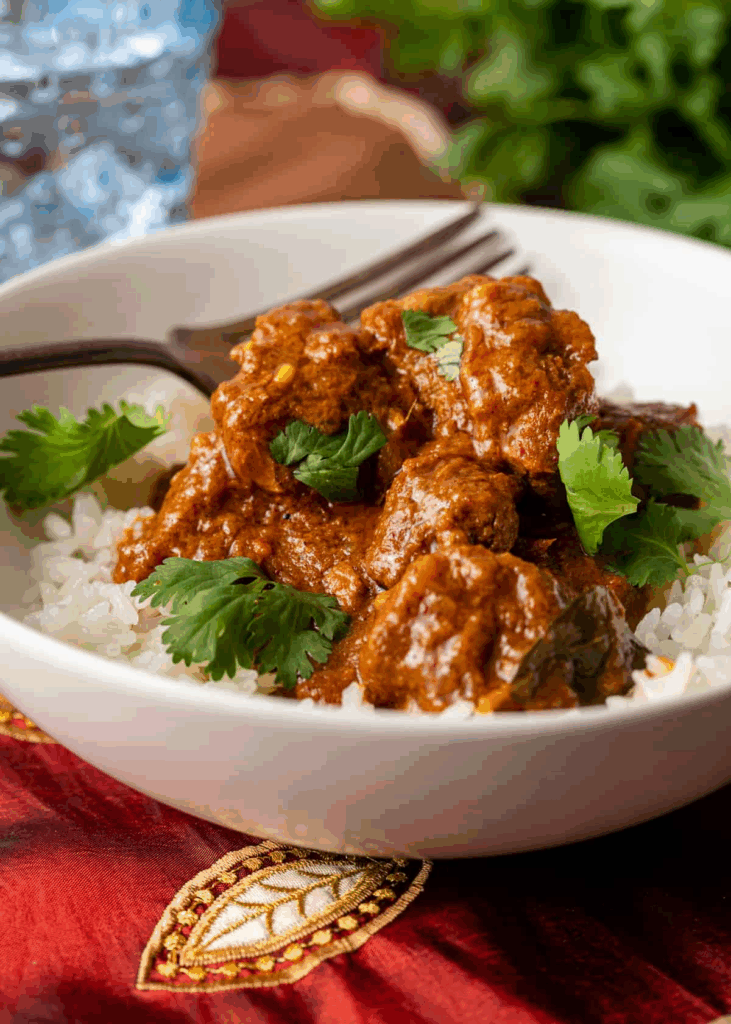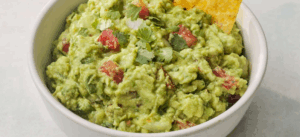Authentic Recipe for Indian Lamb Vindaloo: A Chef’s Full Guide from Spice to Simmer

Lamb vindaloo holds a special place in my kitchen. I’ve made it for rustic family-style dinners and refined restaurant tasting menus. Originally a Goan-Portuguese fusion dish, vindaloo is a fiery, vinegar-forward curry that delivers deep, satisfying flavor with every bite. If you’re ready to go beyond bland takeout versions, I’ll show you how to make real lamb vindaloo with all the spice, tang, and texture it deserves—whether you use a stovetop, oven, or slow cooker.
- Understanding the Origins of Vindaloo
- Ingredients for Traditional Lamb Vindaloo
- Timing Table for Lamb Vindaloo Preparation and Cooking
- Making Vindaloo in a Dutch Oven or Cast Iron Pot
- How to Make Lamb Vindaloo in a Slow Cooker
- Microwave Cooking: Is It Worth Trying for Vindaloo?
- What to Serve with Lamb Vindaloo: Pairing Ideas
- Meat Options and Vegetarian Variations
- Weeknight vs Festive Lamb Vindaloo: Adjusting for Occasion
- Storing and Reheating Lamb Vindaloo Properly
- Comparing Cooking Methods for Vindaloo
- Why Lamb Vindaloo Stands the Test of Time
- FAQ: Authentic Indian Lamb Vindaloo

Understanding the Origins of Vindaloo
Vindaloo is a dish born from colonization and cultural blending. It started as “carne de vinha d’alhos”—a Portuguese preparation of meat marinated in wine and garlic. When it reached the Goan shores of India, local cooks swapped wine for palm vinegar and added their own spices: cumin, cinnamon, mustard seeds, and the famous dried Kashmiri chilies.
What emerged was something unique—bold, tangy, spicy, and complex. Today, most restaurants simplify vindaloo into just “spicy curry,” but real vindaloo is more than that. It has acidity from vinegar, sweetness from onion and sugar, and layered spice from a custom ground masala.
As a chef, I’m fascinated by how vindaloo captures the essence of Goan cuisine—bright, aggressive, and unapologetically bold. And lamb, with its richness, balances the acidity beautifully.
Ingredients for Traditional Lamb Vindaloo
When I prepare authentic lamb vindaloo, I don’t rush the ingredient list. Every element contributes to that deep, aromatic balance. Here’s what I use for a 4-serving batch:
- Lamb shoulder or leg, boneless – cut into cubes. Shoulder is my favorite for its fat content and flavor.
- White vinegar – I use malt vinegar when available; otherwise, distilled white works fine. This is the soul of the dish.
- Garlic and ginger – a generous amount, freshly minced or made into paste.
- Dried red chilies – preferably Kashmiri for color and moderate heat. I soak and grind them into paste.
- Cumin, coriander, cinnamon, cloves, mustard seeds – whole spices toasted and ground into masala.
- Onion – caramelized slowly to bring out sweetness that balances acidity.
- Sugar or jaggery – just a teaspoon to round off the flavors.
- Salt and oil – as needed.
- Turmeric and paprika – for earthiness and hue.
I marinate the lamb in vinegar, salt, garlic, and chili paste for at least 4 hours. The acidity tenderizes the meat while the garlic and chilies penetrate flavor deep into the muscle.
Timing Table for Lamb Vindaloo Preparation and Cooking
| Task | Time Required | Chef’s Insight |
| Preparing spice paste | 10–15 minutes | I toast whole spices and grind fresh for better depth. |
| Marinating the lamb | 4–24 hours | Overnight marination gives maximum tenderness and flavor absorption. |
| Browning meat and onions | 20–25 minutes | This step builds complexity and balances acidity with sweetness. |
| Simmering curry (stovetop) | 60–90 minutes | Low, slow simmering allows lamb to soften and masala to thicken beautifully. |
| Alternative cooking (oven, etc.) | 2–3 hours (see below) | I adjust heat and liquid slightly when switching methods. |
| Resting before serving | 15–20 minutes | I always let vindaloo sit before plating—this mellows sharp edges in the sauce. |
This table helps me stay organized, especially when preparing lamb vindaloo alongside other dishes like Indian Naan bread without tandoor.

Making Vindaloo in a Dutch Oven or Cast Iron Pot
For years, I’ve relied on heavy-bottomed Dutch ovens to get restaurant-level depth in vindaloo. The thick walls retain heat and moisture, letting the lamb simmer slowly until it’s meltingly soft and fully infused with spice.
I begin by heating oil, then adding mustard seeds until they pop. Next, I caramelize the onions deeply—almost to jam stage. Then I stir in the garlic-ginger paste, spice mix, and chili blend, letting it all fry until aromatic. Only then do I add the marinated lamb.
Once everything is combined and seared lightly, I add a splash of water or stock and cover the pot. Then it goes into a 300°F (150°C) oven for 2 to 2.5 hours. This method frees up stove space and gives even cooking without stirring. The sauce thickens slowly, the fat renders, and the acidity mellows perfectly.
I’ve served vindaloo cooked this way at private dinners and tasting menus—and it always outperforms stovetop versions in richness and depth.
How to Make Lamb Vindaloo in a Slow Cooker
When I’m preparing lamb vindaloo for a family gathering or a client’s buffet-style dinner, the slow cooker is my secret weapon. It’s forgiving, deeply flavorful, and almost foolproof if you prep the ingredients right. The trick is doing all the flavor-building upfront, not in the cooker.
I start by browning the lamb and caramelizing the onions in a separate pan. Skipping this step will give you a flatter, one-dimensional sauce. Once the masala paste is bloomed and fragrant, I deglaze the pan and pour everything into the slow cooker with the lamb and a bit of water or stock.
Cooking on low for 6–8 hours or high for 3–4 hours allows the lamb to turn tender and the sauce to reduce beautifully. I leave the lid slightly ajar during the last 30 minutes to let excess moisture escape, concentrating the flavors further. I sometimes finish it with a quick sear or broil before serving, especially if the surface looks too soft.
This version pairs especially well with soft naan or rice, and I often serve it alongside a tray of How to cook Tandoori Chicken in oven for guests who want a mix of heat levels.

Microwave Cooking: Is It Worth Trying for Vindaloo?
Microwave cooking wouldn’t be my first pick for vindaloo—but I’ve tested it more than once in constrained kitchens and during food truck events with limited heat sources. The key is using a microwave-safe dish with a tight lid and dividing the cooking process into manageable phases.
I first prepare the masala paste and marinate the lamb as usual. Then I microwave the lamb in a little oil and vinegar on high for about 10 minutes to start the breakdown process. After that, I mix in the paste and cover tightly, cooking in 5-minute bursts at medium-high power for 20–25 minutes total, stirring occasionally.
The result is surprisingly flavorful, though it lacks the deep caramelization of stove or oven versions. To compensate, I recommend finishing the dish with a quick stovetop simmer if time allows.
This method works best with small batches—one to two servings—and is ideal when you want something close to vindaloo without a full kitchen setup. I always remind students that microwave vindaloo is a shortcut, not a substitute, but still delivers decent results when done right.
What to Serve with Lamb Vindaloo: Pairing Ideas
Lamb vindaloo is rich, spicy, and acidic—so the right sides should either cool, contrast, or absorb. In my kitchen, I focus on pairing with soft, neutral components that balance the intensity.
I usually serve it with steamed basmati rice, which absorbs the sauce beautifully. For something more indulgent, jeera rice (cumin-scented) adds warmth and aroma without overpowering. Indian naan or paratha helps scoop up the curry and gives a chewy textural counterpoint to the tender lamb.
For freshness, I add a cooling cucumber raita—yogurt, grated cucumber, roasted cumin, and a hint of mint. A simple onion salad with lemon juice and salt brightens each bite. And when I really want to impress, I add a trio of chutneys: sweet tamarind, herby coriander-mint, and spicy chili-garlic.
On themed nights, I serve vindaloo after a lighter starter—like What is Indian Dosa and how to make it —because dosa’s mild tang preps the palate for bolder flavors to come.

Meat Options and Vegetarian Variations
Though lamb is the classic choice, I’ve experimented with—and served—many delicious versions of vindaloo. Each protein interacts with the spices differently.
Goat is a close cousin of lamb in texture and flavor. It needs longer cooking but delivers a slightly gamier depth that works beautifully with the vinegar and chili notes. Beef vindaloo, especially using chuck or brisket, becomes rich and hearty, though I reduce the vinegar slightly to match its heavier profile.
For clients who avoid red meat, I use chicken thighs and reduce cooking time. I marinate them just like lamb, but cook faster—usually 30–40 minutes on the stovetop or 25 minutes in the oven at 400°F.
Vegetarian versions aren’t traditional, but they’re incredibly satisfying when done right. I’ve made vindaloo with paneer, mushrooms, and even tofu. The key is not to overwhelm the delicate protein with spice—so I reduce chili quantity and balance it with more paprika and cinnamon. Root vegetables like sweet potato and cauliflower also work well, especially roasted before simmering in the sauce.
When serving multiple dietary preferences, I often offer both meat and veg vindaloo with identical sauces but separate proteins. It’s efficient and pleases everyone at the table.
Weeknight vs Festive Lamb Vindaloo: Adjusting for Occasion
Lamb vindaloo can feel like a celebration meal—and it certainly works for festivals, dinner parties, or slow Sunday cooking. But I also adapt the dish for casual weeknights without sacrificing its character.
For everyday meals, I cut down on marination time (4 hours instead of overnight), reduce the chili heat slightly, and use boneless lamb shoulder pre-cubed. I simmer it uncovered for around 45 minutes, resulting in a lighter curry that still hits the right notes.
For festive versions, I go all in: whole spices toasted fresh, homemade chili paste, longer marination, and lamb bone-in for extra flavor. I simmer low and slow for up to two hours, finish with a touch of jaggery, and garnish with fried curry leaves or toasted mustard seeds for aroma. This version demands patience—but the depth and complexity are worth every minute.
I often pair festive vindaloo with homemade naan, like in this Indian Naan bread recipe without tandoor (вставить ссылку по смыслу здесь — Indian Naan bread recipe without tandoor), which balances the heat and soaks up the vibrant sauce beautifully.
Storing and Reheating Lamb Vindaloo Properly
Like many slow-cooked dishes, vindaloo improves with time. The flavors deepen, the acidity mellows, and the fat continues to tenderize the meat. I often recommend making it a day ahead if you’re cooking for guests.
Once cooled, I store it in an airtight container in the refrigerator for up to 3 days. I always reheat it slowly—either in a saucepan over low heat, stirring occasionally, or in a covered baking dish in the oven at 300°F (150°C) for 20 minutes. This avoids breaking the meat and preserves sauce texture.
For freezing, I portion it into airtight bags or containers, excluding garnishes. It holds up for 2 months and reheats well, especially when stirred into fresh rice or used in wraps.
On my own prep days, I cook a double batch—half for dinner, half for freezing. I’ve even made vindaloo toasties and stuffed parathas using leftovers. It’s a dish that keeps giving.
Comparing Cooking Methods for Vindaloo
| Method | Time Needed | Flavor Depth | Texture | When I Use It |
| Stovetop simmering | 60–90 min | High | Thick, soft | Great for small batches or casual meals. |
| Oven-braising | 2–2.5 hours | Very high | Silky, rich | My favorite for holiday meals or when serving a crowd. |
| Slow cooker | 6–8 hours on low | Medium-high | Extra tender | Ideal for prep-and-leave situations, buffets, or large households. |
| Microwave (with grill) | ~25 minutes | Medium | Softer, slightly looser | Only for quick solo meals or when equipment is limited. |
| Pressure cooker | 30–35 minutes | Good, if spiced right | Soft and slightly dense | Efficient when I need speed without compromising richness. |
Each method has its place. Personally, I reach for the oven when flavor is priority, but rely on the slow cooker during service-heavy days when I can’t babysit the pot.
Why Lamb Vindaloo Stands the Test of Time
There’s something about vindaloo that continues to resonate with every new generation of food lovers. Its balance of heat, tang, depth, and aroma makes it more than just a spicy curry—it’s a showcase of how flavors can evolve across borders.
I keep making vindaloo because it never feels boring. It adapts to different proteins, responds well to experimentation, and offers comfort on any day. Whether served on banana leaves in a Goan village or on bone china at a fine-dining table, it holds its own.
When I teach students, I always say: vindaloo isn’t about fire—it’s about layers. Acidity, sweetness, smoke, heat, and spice come together when you respect each part of the process. And when your guests taste that balance, it tells them everything they need to know about your kitchen.
FAQ: Authentic Indian Lamb Vindaloo
Can I use pork instead of lamb?
Yes, I’ve made pork vindaloo many times. From my experience, pork shoulder or neck works beautifully with the marinade—the fat renders well and balances the vinegar’s acidity. It’s actually more traditional in Goa, where pork vindaloo originated before lamb became more common in restaurant versions.
What’s the best type of vinegar for vindaloo?
I’ve tried malt, white, apple cider—even palm vinegar when I cooked in Goa. Honestly, distilled white vinegar works perfectly fine at home. If you want a deeper, rounded tang, go for malt vinegar. It gives a touch of authenticity and complexity to the final dish.
How can I reduce the heat without losing flavor?
Absolutely doable. I’ve cooked milder versions many times, especially for guests not used to spicy food. I simply reduce the Kashmiri chilies and use more paprika. The dish keeps its color, depth, and sour-sweet backbone—even without the burn.
Do I really need sugar in the sauce?
From my experience, yes—but not much. Just a teaspoon of sugar or jaggery balances the acidity and bitterness from spices. It doesn’t make the dish sweet—it just smooths the sharp corners of the flavor profile.
Can I make vindaloo ahead of time?
Not only can you—I recommend it. Vindaloo tastes even better the next day. The flavors deepen, the sauce thickens, and the meat becomes incredibly tender. I always prep it a day ahead for dinner parties or catering gigs. It’s one of those curries that loves to rest.
What sides go best with lamb vindaloo?
Based on what I’ve served professionally, basmati rice, soft flatbreads, and a cooling yogurt sauce work best. They neutralize the heat and let the sauce shine. I especially recommend pairing it with homemade naan—this Indian Naan bread recipe without tandoor is one of my go-to pairings when I want a complete meal that’s both rich and balanced.
Can vindaloo be vegetarian?
Yes, and I’ve cooked it that way for many clients. Paneer, mushrooms, tofu, or roasted cauliflower all work great. I adjust the spice level and reduce vinegar slightly for a gentler finish. You still get that vindaloo essence—just without the meat.
Why is my meat turning out tough?
In my experience, tough lamb is usually the result of under-marinating or overcooking at high heat. Lamb needs time to break down. Long, slow simmering—either on the stovetop or in the oven—makes a huge difference. I also never skip the vinegar marinade. It does most of the tenderizing before heat even gets involved.
Can I use store-bought vindaloo paste?
I’ve tested a few, and while they’re okay for convenience, they never match a homemade blend. That said, if you’re short on time, I recommend boosting jarred paste with fresh garlic, ginger, and maybe a squeeze of lemon or a splash of vinegar to wake it up.
How do I know when it’s fully cooked?
From my experience, you’ll see oil separating from the sauce, and the meat will be fork-tender. The acidity should mellow, and the aroma turns deep and warm. If the vinegar still dominates, it needs more simmering. Trust your taste and look for that glossy, thick consistency.
Should I skim off the foam during cooking?
I never do. In traditional Indian cooking, the foam is part of the broth. It breaks down and enriches the sauce. Unless it’s excessive, I leave it—it helps build a deep, rustic texture.
Can I use tomatoes in vindaloo?
I’ve tried it, and while not traditional, a touch of tomato puree can work for body. I’d avoid diced tomatoes—they change the dish too much. If you do add tomato, go light and let the vinegar remain the star.
Is it worth grinding whole spices or should I use pre-ground?
In my kitchen, freshly toasted and ground spices always win. The aroma, color, and flavor are on another level. But if you’re in a rush, pre-ground works—just bloom them properly in oil to get their full potential.
How do I keep acidity and heat in balance?
This is where tasting during cooking helps. I usually add vinegar in stages and adjust with a bit of sugar or ghee at the end. I’ve also mellowed sharp vindaloos with a spoon of yogurt or a swirl of cream if needed. It’s all about balance.
Can I serve vindaloo with an appetizer?
Yes—and I often do. One of my favorite pairings is a dosa starter or a small piece of Tandoori Chicken on the side. It gives variety and helps soften the impact of the main dish’s intensity.




Post Comment